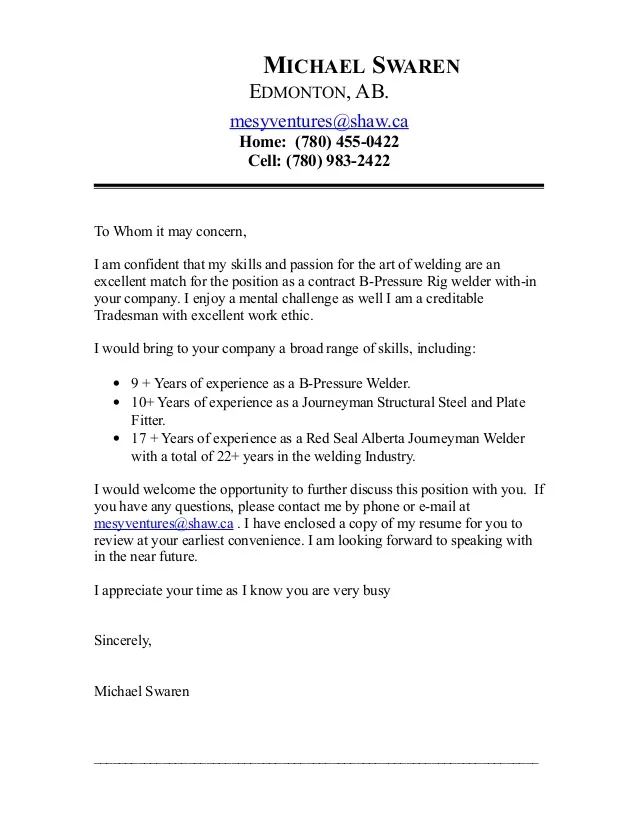Crafting a Compelling Welder Cover Letter
In the competitive field of welding, a well-crafted cover letter is your first opportunity to make a strong impression on potential employers. It serves as a critical tool to showcase your skills, experience, and enthusiasm for the role. Unlike a resume, which provides a factual overview of your qualifications, a cover letter allows you to express your personality and explain why you are the perfect fit for the job. A standout cover letter demonstrates that you’ve taken the time to understand the company’s needs and that you possess the necessary skills and dedication to excel.
Understanding the Importance of a Welder Cover Letter
The importance of a welder cover letter cannot be overstated. It’s your chance to go beyond the basic information provided in your resume and provide a more detailed narrative. It allows you to connect with the hiring manager on a personal level, highlighting your passion for welding and your commitment to quality workmanship. A compelling cover letter can significantly increase your chances of securing an interview, ultimately leading to a job offer. By thoughtfully addressing the requirements of the position and expressing your genuine interest, you set yourself apart from other applicants.
Why a Cover Letter Matters for Welders
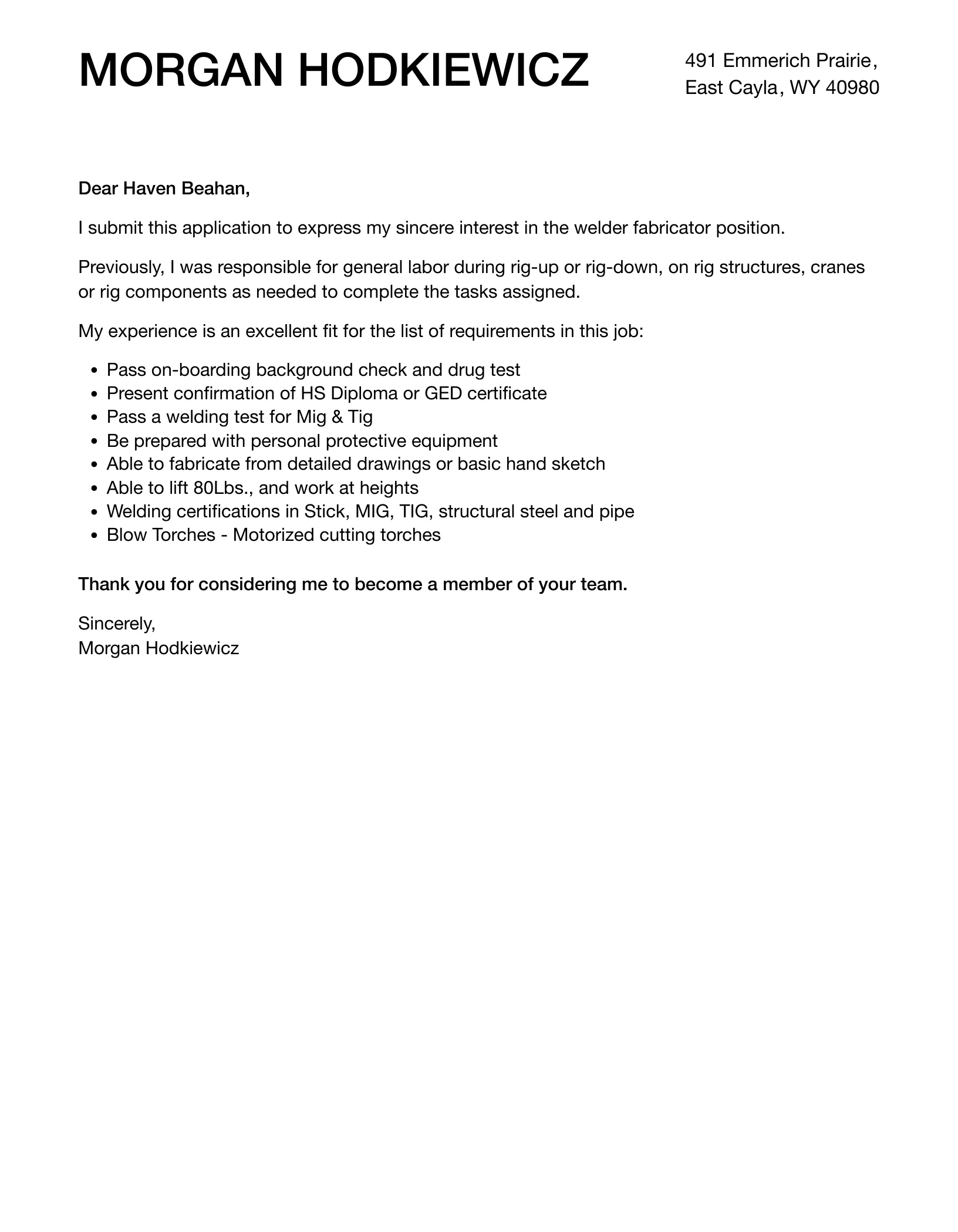
For welders, a cover letter is especially crucial because it allows you to explain the context of your skills. Welding is a highly specialized trade, and the demands of each job can vary significantly. Your cover letter should highlight your specific experience and the types of welding you’ve performed, whether it’s MIG, TIG, stick welding, or other specialized techniques. Moreover, it allows you to showcase any unique projects or accomplishments that demonstrate your abilities. This level of detail is difficult to convey in a resume alone.
Key Components of a Strong Welder Cover Letter
Creating a strong cover letter involves several key components that work together to present you as a qualified and enthusiastic candidate. From the initial greeting to the closing, each element should be carefully crafted to grab the reader’s attention and make a lasting impression. A well-structured cover letter not only provides information but also demonstrates your professionalism and attention to detail. It showcases your ability to communicate effectively, which is essential in any workplace environment.
Contact Information and Salutation
Start your cover letter with your contact information, including your full name, address, phone number, and email address. Then, address the hiring manager directly, if possible. If you can find the name of the person responsible for hiring, using “Dear Mr./Ms. [Last Name]” is always preferable to a generic greeting. This personal touch shows that you’ve taken the time to research the company and the specific job opportunity. If a name is unavailable, use a professional greeting like “Dear Hiring Manager”.
Writing a Compelling Opening
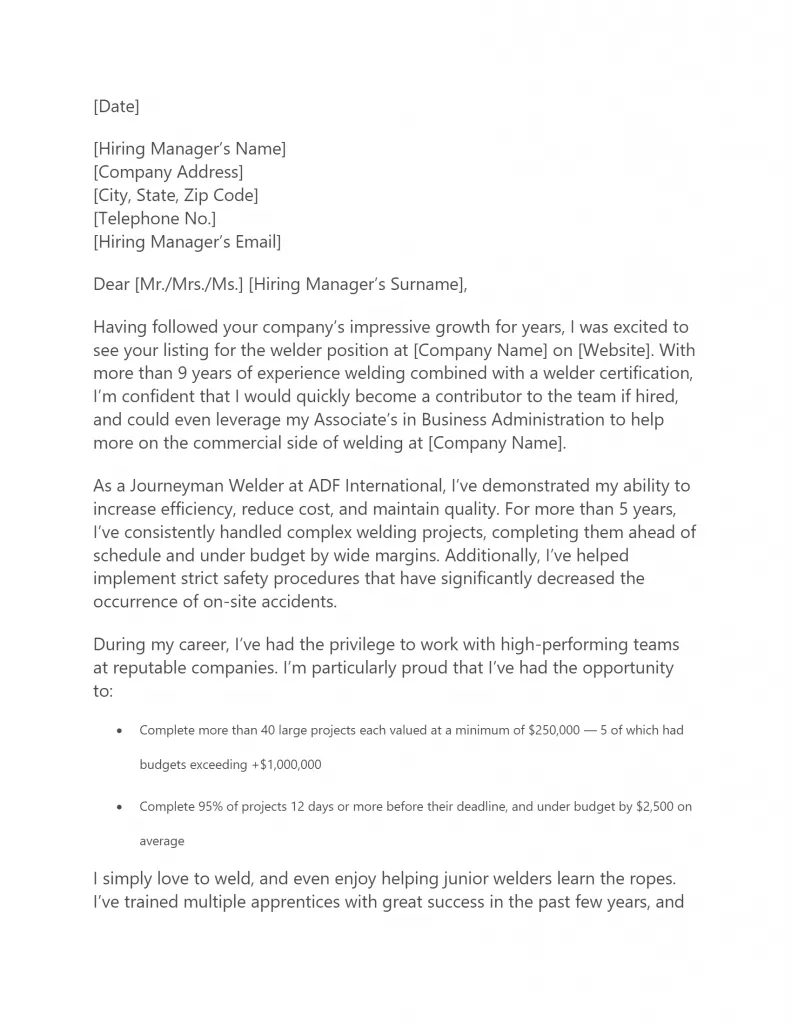
Your opening paragraph should immediately capture the reader’s attention. State the position you’re applying for and where you saw the job posting. Then, briefly highlight your most relevant qualifications and experience. The opening should convey your enthusiasm for the opportunity and briefly state why you are a strong candidate. Keep it concise and impactful; this is your first chance to create a positive impression and encourage the reader to continue reading the rest of your letter.
Highlighting Relevant Welding Skills and Experience
The body of your cover letter is where you showcase your welding skills and experience. Focus on the specific skills and experiences that align with the job requirements. Instead of simply listing your qualifications, provide specific examples of how you’ve used your skills to achieve positive results. Quantify your accomplishments whenever possible; for example, mention how you improved welding efficiency or reduced material waste. Explain your experience with different welding processes and materials to demonstrate your versatility and expertise. Tailor this section to the job description, emphasizing the skills and experiences the employer is looking for. (Image: welder-skills-example.webp)
Technical Skills to Include
Be specific about your technical skills. List the welding processes you are proficient in, such as MIG, TIG, stick, and flux-cored arc welding. Include details about the materials you’ve worked with, such as steel, aluminum, and stainless steel. Highlight any experience with specialized welding techniques, such as pipe welding or robotic welding. Mention any skills related to blueprint reading, quality control, and safety procedures. Demonstrate a comprehensive understanding of welding techniques and safety protocols.
Work Experience and Accomplishments
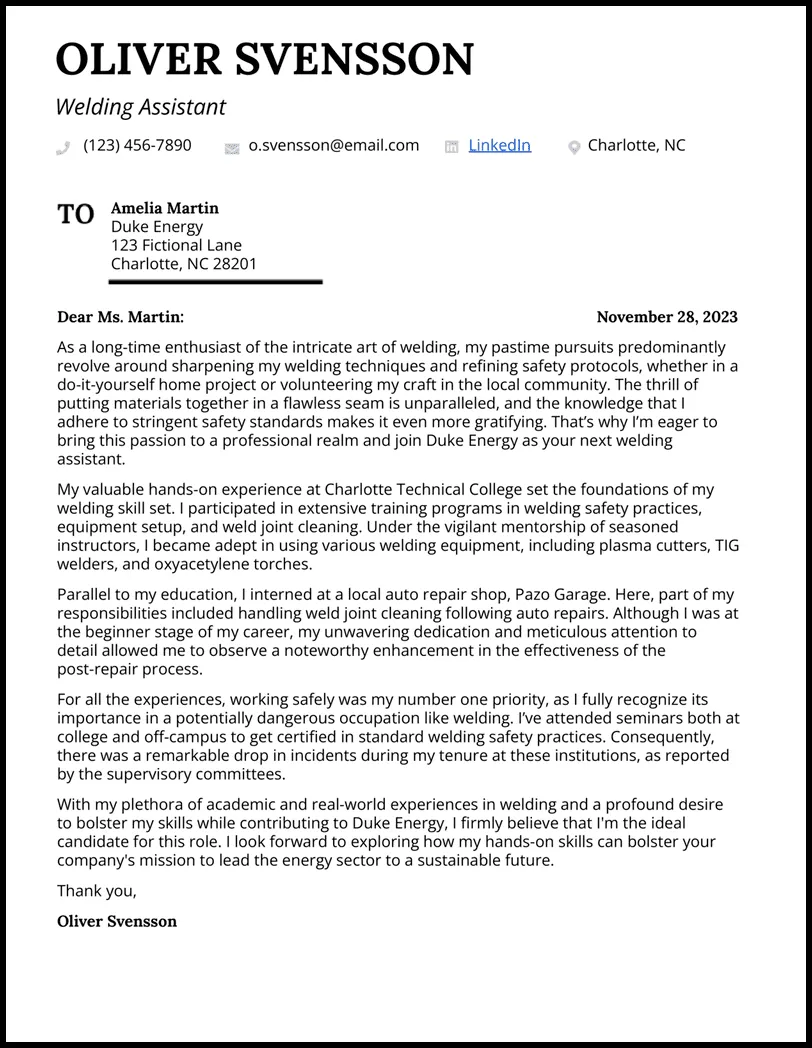
Describe your previous work experience, emphasizing relevant accomplishments. Instead of just listing your job duties, focus on the results you achieved. Did you complete projects on time and within budget? Did you receive any awards or recognition for your work? Quantify your accomplishments whenever possible. For instance, “Reduced material waste by 15% through improved welding techniques.” Provide examples of how you’ve solved problems, improved efficiency, and contributed to the success of your previous employers. Your goal is to show the value you can bring to the new company.
Showcasing Certifications and Qualifications
Include all relevant certifications and qualifications in your cover letter. List any certifications you hold, such as AWS (American Welding Society) certifications or other industry-recognized credentials. Specify the types of welding processes and materials covered by your certifications. Mention any specialized training you’ve received, such as courses in advanced welding techniques or safety procedures. Including certifications demonstrates your commitment to the profession and confirms your qualifications. (Image: welder-certifications.webp)
Mentioning Specific Projects and Achievements
When describing your experience, provide details about specific projects you’ve worked on. Mention the type of project, your role, and the outcomes. If you worked on a particularly complex or challenging project, describe the problem and how you solved it. Highlight any awards or recognition you received for your work. This provides concrete examples of your abilities and gives the hiring manager a clearer picture of your capabilities. For example, “Successfully completed the fabrication of a complex steel structure for a commercial building, adhering to all safety regulations and achieving perfect weld quality.” (Image: welder-project-example.webp)
Expressing Enthusiasm and Interest
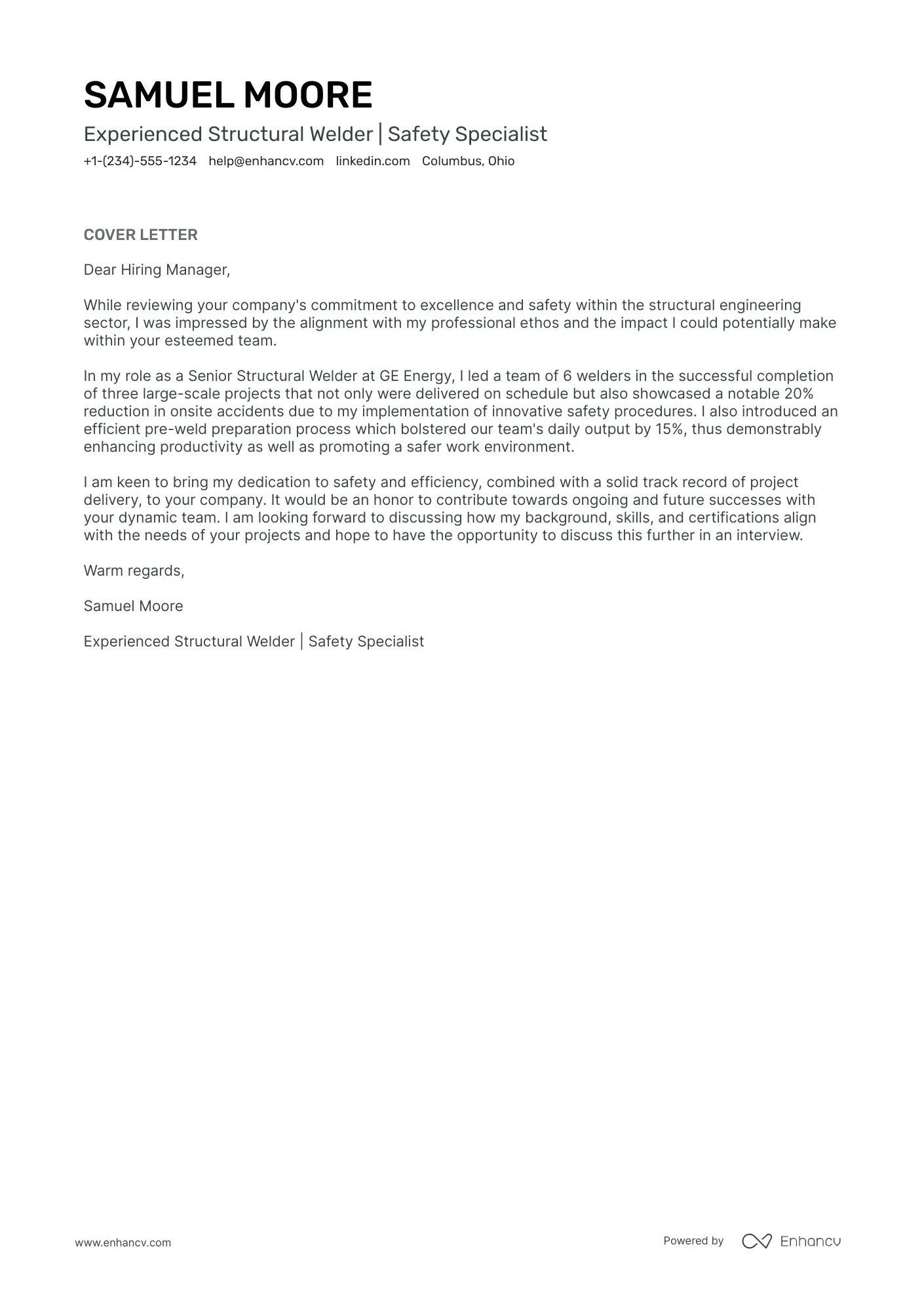
Show your genuine enthusiasm for the position and the company. Explain why you are interested in working for this specific employer and how your values align with their mission. Research the company and mention specific aspects that appeal to you, such as their innovative projects, commitment to quality, or positive work environment. Demonstrate that you’re not just looking for any job but are genuinely interested in this particular opportunity. Expressing enthusiasm will make you stand out from other applicants. (Image: welder-enthusiasm.webp)
Call to Action and Closing
In your closing paragraph, reiterate your interest in the position and express your eagerness for an interview. Clearly state that you are available for an interview and provide your contact information again. Thank the hiring manager for their time and consideration. Use a professional closing such as “Sincerely” or “Best regards,” followed by your name. Your closing should reinforce your enthusiasm and leave a lasting positive impression. (Image: welder-closing.webp)
Reviewing and Editing Your Welder Cover Letter
Before submitting your cover letter, it’s crucial to review and edit it carefully. This ensures that your letter is free of errors and presents you in the best possible light. Proofreading and tailoring your letter to each job application are essential steps in the job-seeking process. A polished, well-edited cover letter demonstrates your professionalism and attention to detail, increasing your chances of success.
Proofreading for Errors and Clarity
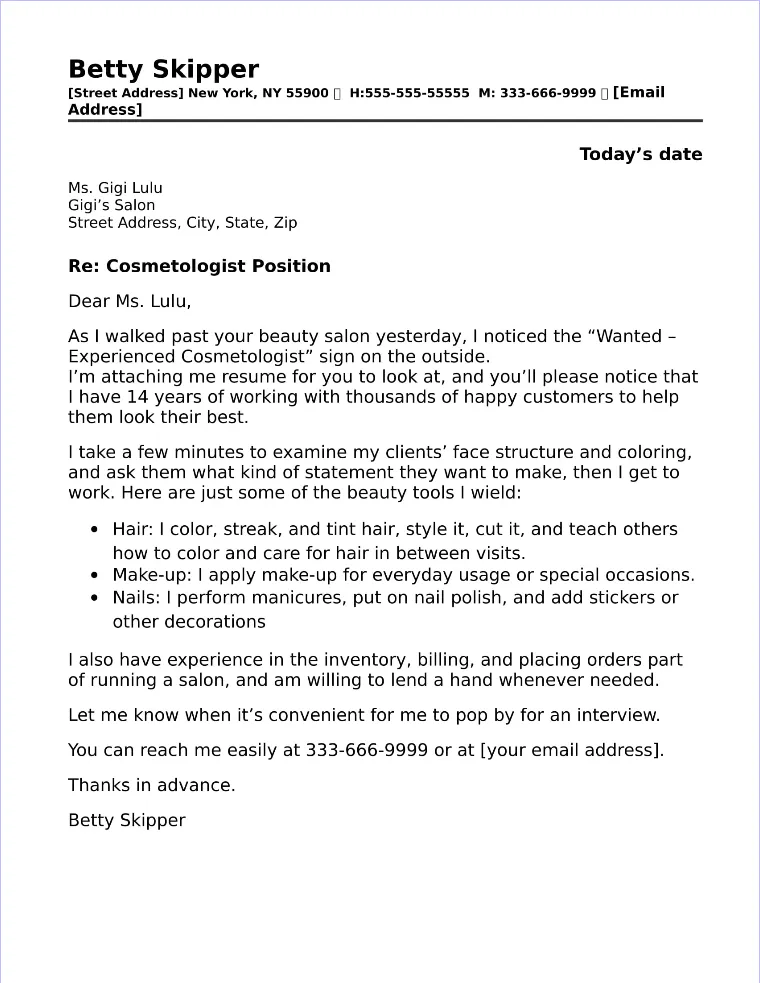
Carefully proofread your cover letter for any spelling, grammar, or punctuation errors. Typos and grammatical mistakes can create a negative impression and make you seem unprofessional. Read your letter aloud to catch any awkward phrasing or sentences that don’t flow smoothly. Consider having a friend, family member, or career counselor review your letter for clarity and accuracy. Ensure that your writing is concise, clear, and easy to understand. Pay close attention to the overall tone and style to ensure it is appropriate for a professional setting.
Tailoring Your Cover Letter to Each Job
Customize your cover letter for each job application. Avoid using a generic cover letter that you send to every employer. Instead, carefully review the job description and tailor your letter to match the specific requirements and qualifications. Highlight the skills and experience that are most relevant to the position. Research the company and mention specific projects or aspects that interest you. Customizing your letter shows the hiring manager that you are genuinely interested in the opportunity and have taken the time to understand their needs. By personalizing your cover letter, you increase your chances of making a strong impression.
Formatting Best Practices
Use a professional and easy-to-read format. Choose a standard font, such as Times New Roman, Arial, or Calibri, and use a font size between 10 and 12 points. Maintain consistent formatting throughout the letter, including margins, spacing, and bullet points. Keep your letter concise, ideally no more than one page. Use clear headings and subheadings to break up the text and make it easier to read. Ensure that your cover letter is well-organized and visually appealing. A well-formatted cover letter makes a positive first impression and demonstrates your attention to detail. (Image: welder-resume-review.webp)
